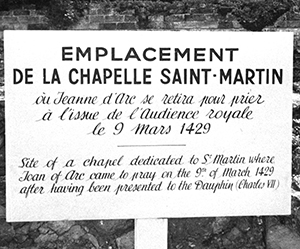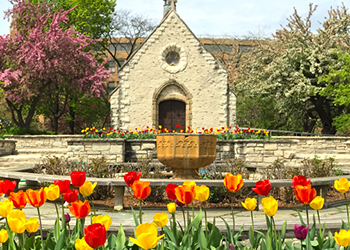St. Joan of Arc's Connection to the Chapel
Joan of Arc (1412–31), daughter of a tenant farmer in northeastern France, took up her divine mission to save France by expelling its enemies and aiding Charles of Valois in becoming the country's rightful king after hearing the voice of God. At the age of 18, Joan led the French army to victory over the British at Orléans during the Hundred Years' War. This victory led to the ousting of Henry V and the coronation of Charles VII. Joan was captured in battle in the spring of 1430 by the Burgundians, who traded her to the English. Charles VII, still unconvinced of Joan's divine mission, made no attempt to rescue her. On May 29, 1431, Joan was declared a heretic and burned at the stake the following day at the marketplace in Rouen. In 1456, King Charles VII ordered an investigation into Joan's trial and declared her an innocent martyr. Joan of Arc was canonized by Pope Benedict XV in 1920.

St. Joan of Arc's connection to the chapel at Marquette has been debated over the years. Photographs of signs posted at a previous site of the chapel indicate St. Joan may have prayed in there after meeting with King Charles VII on March 9, 1429. At that time, the chapel was dedicated to St. Martin de Sayssuel. Mystery has also surrounded the "Joan Stone," which sits at the base of an opening behind the altar. Legends say St. Joan prayed to the Virgin Mary while standing on this stone. After finishing her prayer, St. Joan knelt down and kissed the stone. Ever since, the stone has remained colder than those around it.
According to a Marquette Tribune article from 1967, the first mention of the stone came from John Russel Pope, the architect who planned the reconstruction of the chapel on Long Island, N.Y. The same article mentions no one knows how the stone came to be a part of the chapel. A clue may reside in the files of Gertrude Hill Gavin, who purchased and relocated the chapel to Long Island in 1926. As of now, however, the mystery remains unresolved.

